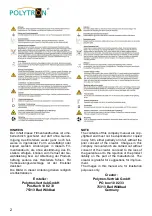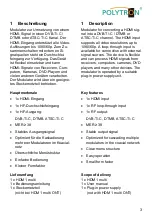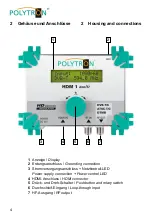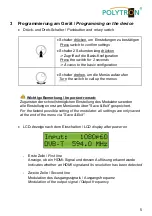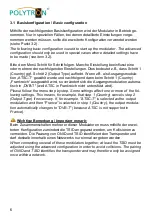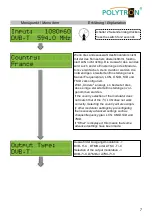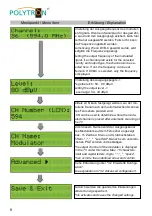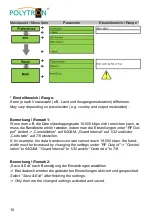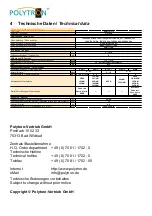
6
3.1 Basiskonfiguration /
Basic configuration
Mithilfe der nachfolgenden Basiskonfiguration wird der Modulator in Betrieb ge-
nommen. Nur in speziellen Fällen, bei denen detaillierte Einstellungen vorge-
nommen werden müssen, sollte die erweiterte Konfiguration verwendet werden
(siehe Punkt 3.2).
The following basic configuration is used to start up the modulator. The advanced
configuration should only be used in special cases where detailed settings have
to be made (see item 3.2).
Bitte dem Menü Schritt für Schritt folgen. Manche Einstellung beeinflusst eine
oder mehrere der nachfolgenden Einstellungen. Dies bedeutet z.B., dass Schritt 1
(Country) ggf. Schritt 2 (Output Type) aufhebt. Wenn z.B. als Ausgangsmodula-
ti
on „ATSC-T“ gewählt wurde und nachfolgend dann beim Schritt 1 (Country)
„Frankreich“ ausgewählt wird, so verändert sich die Ausgangsmodulation automa-
tisch in „DVB-T“ (weil ATSC in Frankreich nicht unterstützt wird).
Please follow the menu step by step. Some settings affect one or more of the fol-
lowing settings. This means, for example, that step 1 (Country) cancels step 2
(Output Type) if necessary. If, for example, "ATSC-T" is selected as the output
modulation and then "France" is selected in step 1 (Country), the output modula-
tion automatically changes to "DVB-T" (because ATSC is not supported in
France).
Wichtige Bemerkung /
Important remark:
Beim Zusammenschalten mehrerer dieser Modulatoren muss mithilfe der erwei-
terten Konfiguration zumindest die TSID angepasst werden, um Kollisionen zu
vermeiden. Die Paarung von ONID und TSID identifiziert den Transponder und
darf deshalb innerhalb eines Netzwerks nur einmal vergeben werden.
When connecting several of these modulators together, at least the TSID must be
adjusted using the advanced configuration in order to avoid collisions. The pairing
of ONID and TSID identifies the transponder and may therefore only be assigned
once within a network.
Summary of Contents for HDM 1 multi
Page 11: ...11 Notizen Notes...


